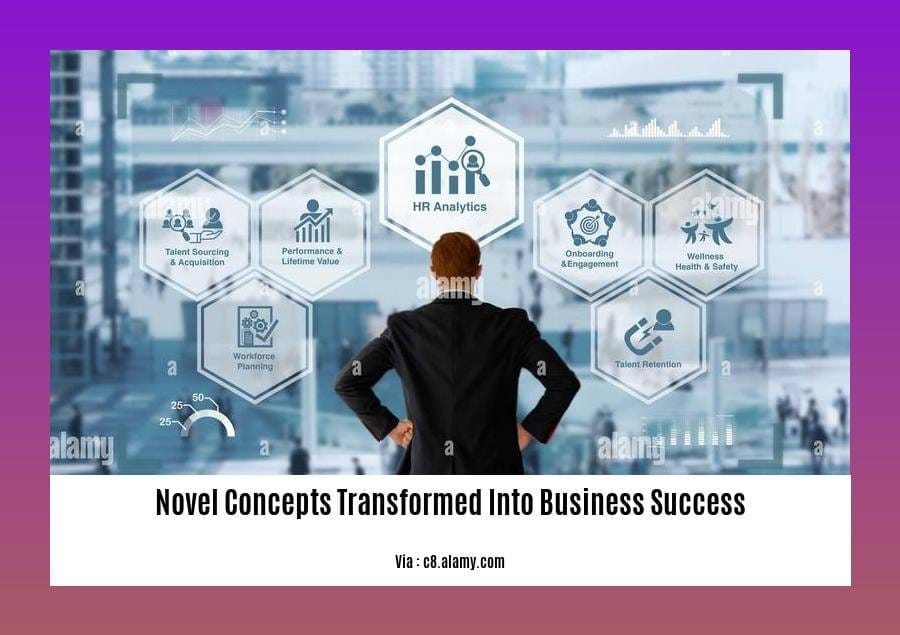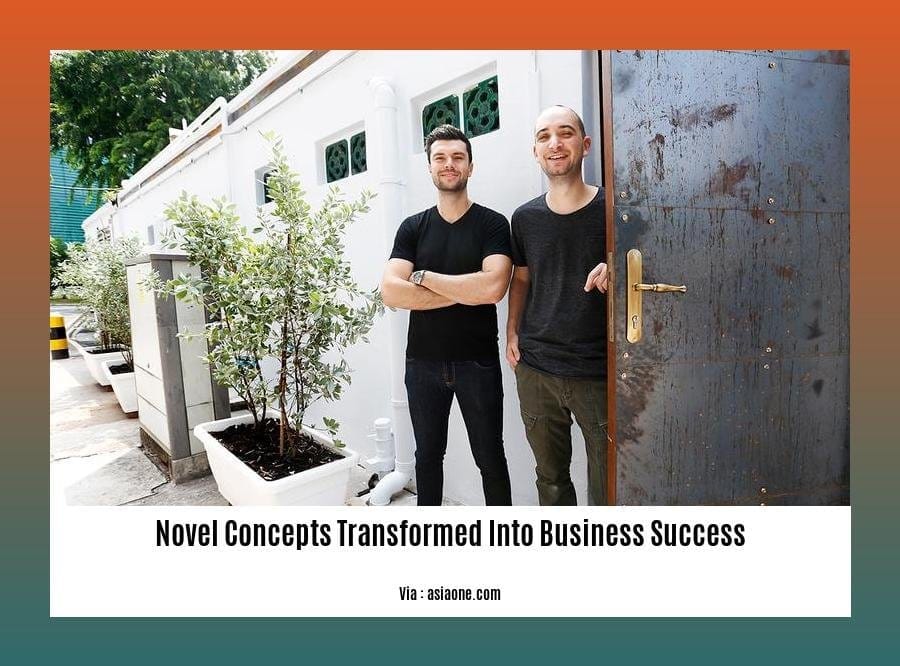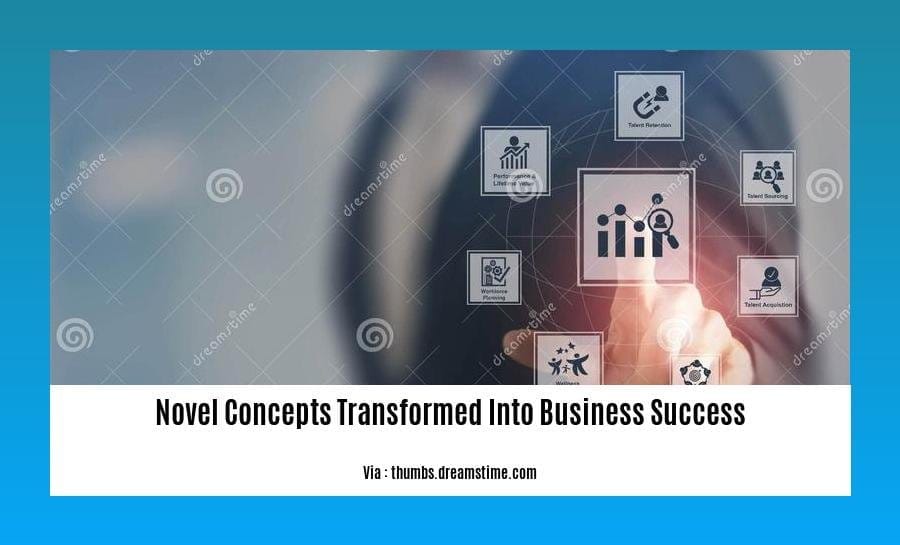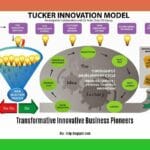Unlock the transformative power of novel concepts and propel your business to new heights! In this article, [Novel Concepts Transformed into Business Success: Strategies and Best Practices for Entrepreneurs], we dive into the world of innovation, where visionary ideas ignite entrepreneurial flames. Learn from experts and discover the secrets to identifying promising concepts, crafting winning market strategies, and executing tailored plans that drive growth and profitability. Get ready to harness the potential of novel ideas and unleash the entrepreneurial spirit within you.

Key Takeaways:
- Innovation drives business success.
- Avoid suppressing innovation through leadership behaviors.
- Focus on solving customer problems.
- Enhance product accessibility to expand opportunities.
- Embrace an entrepreneurial mindset to find new solutions.
Novel Concepts Transformed into Business Success
Innovation is paramount for businesses to thrive in today’s dynamic market. However, certain leadership practices can inadvertently stifle innovation, such as micromanagement or fostering a culture of fear. To cultivate a thriving environment for novel concepts transformed into business success, it’s crucial to prioritize customer needs. Understanding your target audience’s pain points and addressing them is key.
Consider expanding your reach and increasing accessibility, opening doors to new business opportunities. Embrace the entrepreneurial mindset by questioning assumptions, exploring alternative solutions, simplifying processes, and fulfilling unmet needs. Remember, innovation isn’t limited to technology; it encompasses all aspects of business.
Here are some additional tips for fostering a culture of innovation:
- Encourage experimentation: Allow employees to test new ideas without the fear of failure.
- Reward innovation: Recognize and celebrate successes, big and small, to motivate your team.
- Foster collaboration: Create opportunities for employees from different departments to share ideas and perspectives.
- Seek external input: Engage with customers, industry experts, and partners to gain fresh perspectives.
By embracing these strategies, you can create an environment where novel concepts transformed into business success thrive.
Discover the remarkable stories of innovators who commercialized pioneering concepts and how they turned their groundbreaking ideas into profitable ventures. Dive into the intriguing tales of pioneers whose ideas became wildly profitable and explore the brilliance behind their business strategies. Witness the ingenuity of pioneering inventions that were brilliant businesses and how they revolutionized entire industries.
Execute Tailored Plans for Growth and Profitability
To execute plans for growth and profitability, it’s crucial to:
1. Map Out a Long-Term Strategy:
- Set clear long-term goals and create a roadmap to guide your transformation journey.
- Identify key objectives and milestones to track progress and stay on course.
2. Explore and Experiment:
- Conduct thorough market research to understand industry trends and customer needs.
- Try out various approaches and experiment with new ideas to find what works best.
- Be adaptable and willing to pivot when necessary.
3. Invest in Transformation Capabilities:
- Build a team of skilled professionals who can drive the transformation process.
- Develop internal processes and systems to support continuous improvement.
- Seek external expertise when needed to fill knowledge gaps.
4. Empower Leadership:
- Secure buy-in from top management and ensure their active involvement in the transformation.
- Provide leaders with the resources and training they need to effectively guide the team.
5. Foster a Culture of Innovation:
- Create an environment where employees feel comfortable taking risks and experimenting.
- Encourage collaboration and cross-functional teamwork to facilitate idea generation.
- Reward and recognize employees for their contributions to the transformation process.
Key Takeaways:
- Successful transformations require a long-term commitment and a clear vision.
- Exploration and experimentation are essential for adapting to changing market dynamics.
- Investing in transformation capabilities supports continuous improvement.
- Empowering leadership and fostering innovation are crucial for a successful transformation.
Citation:
Leverage Emerging Trends and Technologies
In today’s rapidly evolving business landscape, it’s imperative to harness cutting-edge trends and technologies to fuel growth and success. By identifying emerging opportunities and implementing tailored strategies, businesses can gain a competitive edge and unlock their full potential.
Steps to Leverage Emerging Trends and Technologies:
- Assess Current State: Evaluate your existing technology infrastructure, market position, and business goals.
- Define Goals: Identify specific objectives you aim to achieve through technology adoption.
- Identify Solutions: Explore emerging technologies, such as AI generativity, super apps, and ambient experience, that align with your goals.
- Implement Technology: Integrate new technologies into operations, ensuring seamless adoption and alignment with business processes.
- Train Employees: Provide comprehensive training to empower staff to leverage new technologies effectively.
- Evaluate Results: Monitor adoption, usage, and impact to refine your strategy and optimize outcomes.
Key Takeaways:
- Emerging trends: Gartner’s Emerging Tech Impact Radar highlights technologies with transformative potential.
- Adapt to change: Digital nomadism and sustainable development necessitate embracing tech advancements.
- Leveraging technology: Technology drives efficiency, innovation, and growth in business operations.
- Plan and execute: Six steps provide a roadmap to successfully integrate emerging trends and technologies.
- Commitment and innovation: Embrace a long-term commitment to transformation and foster a culture of innovation.
Citation:
- Gartner: 30 Emerging Technologies That Will Guide Your Business Decisions
Guide startups and established businesses to navigate market dynamics
Staying ahead in the ever-shifting business landscape requires the ability to adapt and navigate market dynamics. While startups and established businesses face unique challenges and advantages, they can both benefit from a strategic approach to market navigation.
Key Takeaways:
- Embracing agility and flexibility is crucial for startups.
- Established businesses should leverage their resources and connections.
- Market analysis is essential for identifying opportunities and threats.
- Adapting to market changes can lead to competitive advantages.
- Collaboration and continuous learning are vital for success.
Steps to Navigate Market Dynamics:
1. Market Analysis:
- Conduct regular market research to monitor industry trends.
- Keep up with global and local market dynamics.
- Pay attention to consumer preferences and emerging needs.
2. Agility and Flexibility:
- Startups should leverage their ability to pivot quickly.
- Established businesses need to encourage innovation and experimentation.
3. Resource Management:
- Established businesses have access to infrastructure, resources, and networks.
- Startups should seek external funding and partnerships to supplement their limited resources.
4. Collaboration and Innovation:
- Promote collaboration between different departments and teams.
- Create an environment that fosters creativity and risk-taking.
5. Continuous Learning:
- Stay informed about industry best practices and emerging technologies.
- Invest in training and development for employees.
6. Adaptability:
- Be prepared to adjust strategies and operations based on market feedback.
- Respond promptly to market changes and disruptions.
Conclusion:
Navigating market dynamics requires a combination of strategic planning, agility, and continuous adaptation. By implementing the strategies outlined above, both startups and established businesses can position themselves for success in the dynamic business environment.
Citation:

FAQ
Q1: What is the most important aspect to consider when transforming a novel concept into a business success?
Q2: How can businesses overcome challenges and thrive in a rapidly changing market landscape?
Q3: What strategies can entrepreneurs implement to identify and develop promising novel business ideas?
Q4: How can businesses leverage technology to transform their operations and drive growth?
Q5: What is the role of adaptability and resilience in achieving business success in the modern era?
- Crypto Quotes’ Red Flags: Avoid Costly Mistakes - June 30, 2025
- Unlock Inspirational Crypto Quotes: Future Predictions - June 30, 2025
- Famous Bitcoin Quotes: A Deep Dive into Crypto’s History - June 30, 2025
















